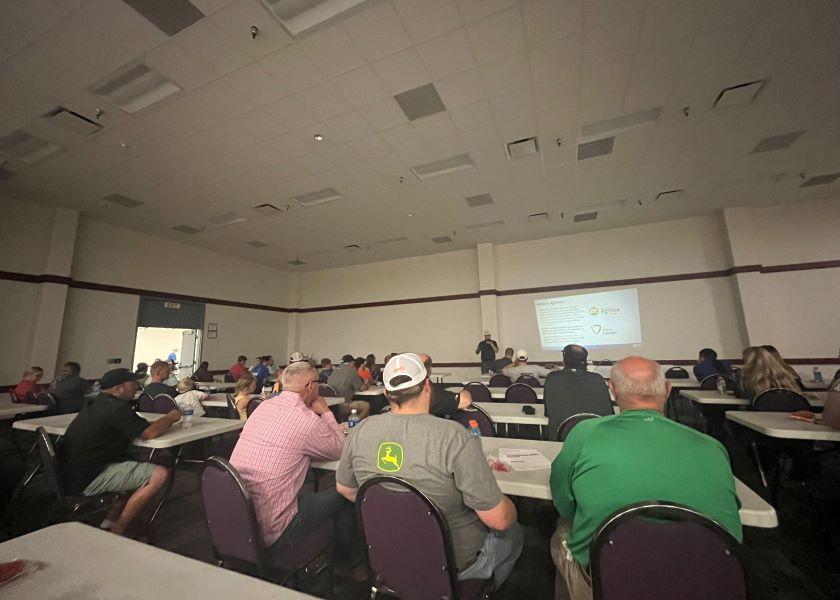Show Pig Industry Gathers to Discuss ASF Prevention and Preparedness

The U.S. pork industry has a plan to help keep foreign animal diseases like African swine fever (ASF) out of the country, but it requires everyone in the pork industry to do their part.
“We must be proactive,” Matt Claeys, CEO of the National Swine Registry, said before a large crowd of youth swine exhibitors and purebred swine breeders at the National Junior Summer Spectacular in Louisville, Ky., last week. “Do your part. Get engaged with your state pork association. Be responsible and utilize the programs the National Pork Board has created to help protect the U.S. swine industry.”
John Heins, strategic account manager for the National Pork Board said it’s important to consider what the show pig industry can do collectively to safeguard an industry they love.
“Every time you sell a pig, 35 cents out of that $100 value of that animal comes to the Pork Checkoff. We distribute that money on your behalf towards prevention, education and research in the swine industry,” Heins explained. “We provide resources to producers that allow them to be sustainable – from a business continuity standpoint. We want to help you remain profitable.”
In a study led by Dermot Hayes, an economist with Iowa State University, analysis shows an ASF outbreak would result in a $79.5 billion impact on the pork and beef industries and directly impact 60,000 industry workers with job loss. Pork prices would drop between 50% and 60% and would stay low for three years before recovering. Read the full study here.
Heins challenged attendees to do their part by completing two critical calls-to-action.
1. Create an account on AgView and become familiar with the template. Start logging movements to assist from a traceability standpoint.
2. Work with your veterinarian to create a Secure Pork Supply plan for your farm.
Programs like AgView and Secure Pork Supply are two opportunities for producers to show state animal health officials that they are committed to doing the right thing, Heins said.
Enroll in AgView Now
AgView, a Checkoff-funded , opt-in technology solution helps producers with operations of all sizes and types provide disease status updates and pig movement data to state animal health officials. Heins said that it ties all pig movements to a farm’s premises ID, allows the producer or show pig exhibitor to gather data prior to any disease incidents, holds data securely, and releases data only when the exhibitor or producer chooses to do so. Plus, Heins said it’s easy to use.
“It's important for us as an industry to think about what we can do to provide that asset protection for a segment that we all love and ensure that we want to continue to be a part of it,” Heins said.
He demonstrated to attendees how to log into the AgView website, create an account and enter premise IDs. He encouraged them to start tracking pig movements immediately. He added that although this isn’t hard to do, future iterations will make tracking movements even easier.
Create a Secure Pork Supply Plan Now
Seth Mitchell, manager of state pork industry relations at the National Pork Board, shared how creating a Secure Pork Supply plan can help set pork producers up for success.
“Secure Pork Supply provides a workable business continuity plan for sites that are under movement restrictions, but not infected with foot-and-mouth disease (FMD), classical swine fever (CSF) or ASF. It offers movement guidance for producers and officials managing the outbreak and provides biosecurity and surveillance tools for producers,” Mitchell said.
If an outbreak would occur, the response will be to stop the spread of animal disease, Mitchell said. Control areas will be set up around infected and surrounding farms. Movement restrictions will be put in place for animals and animal products in the regulatory control area.
Mitchell said a Secure Pork Supply plan will help sites and control areas whose pigs have no signs of FMD, CSF or ASF, continue to raise animals and return to business. It will limit carcass disposal problems and lost income for producers and their sites, as well as for haulers, processors and grocers. Most importantly, it will maintain the supply of pork and pork products to consumers because CSF, ASF and FMD are not public health or food safety concerns.
“We can each be a voice to help move our industry forward,” said Todd Kennedy, sales manager at Show-Rite Feeds. “They are telling us we ‘should’ do this and I’m telling you we ‘must’ do this to help protect the U.S. pork industry as a whole.”
Create your Secure Pork Supply plan here.
Read More from Farm Journal's PORK:
It’s Time to Bridge the Gap Between the Show Ring and Production Ag







